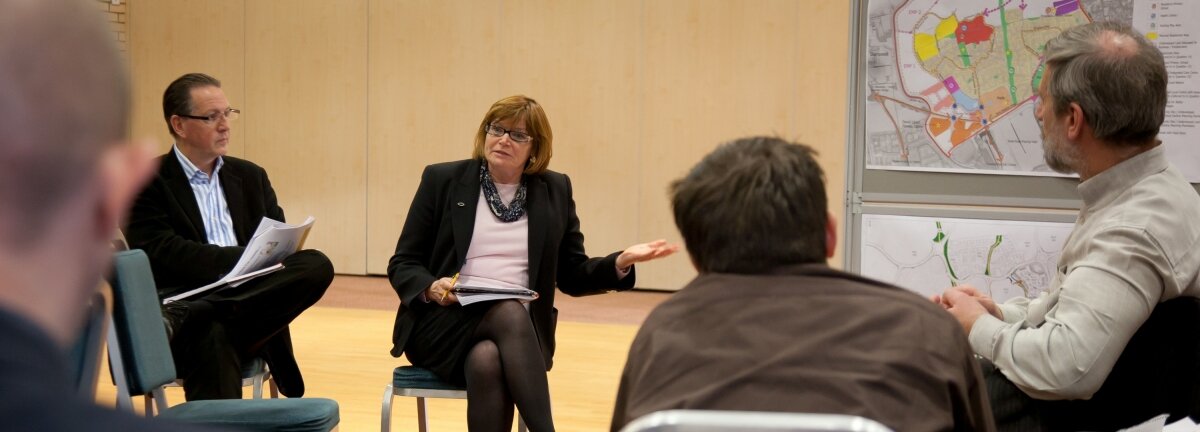Resolving disputes over planning and design – is there another way?

Delivering high quality new development requires a range of skills and competencies, and is a truly multi-disciplinary process. Bringing forward new development at scale and pace inherently carries risk and brokering between parties is increasingly common as we see the scale of development grow across the country.
This article explores the way that Design Council Cabe and our Built Environment Experts (BEEs) help provide such brokering to facilitate and enable new development to come forward. Brokering between parties can involve mediation, in essence a structured solution to reconciling differences and priorities.
Urban design remains a key component of planning decisions, at all scales. A recent planning application refusal was made against building a new development of 19 houses on the edge of a village in Essex, as: ‘visually intrusive urbanisation of the countryside outweighs housing need.’ (Planning Resource, 13 August 2015). As a result, the village retained its character and the residents were satisfied; and yet an urgent need for housing remained unresolved.
Could this issue have been tackled differently, perhaps in a way that would have been beneficial for both the developers and the proposed residents as well as those already living in the village?
Brokering or mediation might have saved time, money and resulted in a better outcome that was acceptable to everyone.
What is mediation?
Decisions around the design or layout of a building or development are rarely black and white matters, ill-suited to the ‘yes or no’ planning system. A policy allocating land at the end of a street for housing may require it ‘to be in keeping with its environment’ - but there is great scope for interpretation of what this means in terms of its scale, height and appearance and the way it connects to the existing neighbourhood.
Mediation is a tool that brings different parties together to help address challenging issues.
Mediation is a tool that brings different parties together to help address challenging issues or resolve disputes through a structured negotiation with the help of an independent facilitator. It is a voluntary process where the decisions remain in the hands of the parties around the table, rather than being made by a planning inspector or judge. A mediated process allows the concerns and priorities of a local authority and community, as well as a developer, to be voiced and options generated for consideration.
The earlier that techniques and the process of mediation are applied, the more scope there is to avoid conflict and tackle challenging issues in a constructive way. Our Skelton and Brotton case study illustrates the different development challenges faced by neighbouring villages - ‘residents of Brotton were concerned about the future of their village centre and the possibility of excessive residential development.’ Design Council Cabe worked with the Parish Council, the local community and Redcar and Cleveland Borough Council to help local people set out their own design and development principles through their Neighbourhood Plan.
How can meditation help the planning process?
At its simplest, mediation is about facilitating a discussion and helping a range of different voices articulate what they want to achieve. Cabe has helped a number of local authorities, developers and other stakeholders work together in this way to agree shared design objectives for a site.
At its simplest, mediation is about facilitating a discussion.
At Cranbrook, a large-scale new community in Devon, we have been working with East Devon District Council and the New Community Partners (a consortium of developers) to review the Cranbrook Vision in planning for the next phase of development. We’ve done this through a series of workshops to help set out design priorities and respond to lessons learnt from the completed housing.
In its Guide to the use of mediation in the planning system in Scotland (2009), the Scottish Government recognises the benefits of mediation, including as a tool to break deadlock, ensure better decision-making and encourage meaningful engagement from all interested parties. This final point is important – mediation in the planning context is slightly different to, say, a commercial dispute in that it there are often many parties with a stake in the decision, including the local community.
Design Council Cabe BEE John Pugh-Smith, both a practising planning barrister and a trained mediator, describes the demands of multi-party mediations as requiring facilitation - to help build trust - and brokering - to help focus on the issues for negotiation, rather than the personalities.
More information about mediation in planning
If this is the first you have heard of the use of mediation in design and planning, you may be asking why we aren’t seeing it used more often. One reason may be the change in mind-set required from what has often been an adversarial system between those proposing development and those regulating it, primarily Local Planning Authorities. Some will still want their ‘day in court’.
And if you are interested in reading more, Mediation in Planning: a short guide (NPF, 2011, updated 2014) provides information on when mediation is appropriate and how to go about it.
Subscribe to our newsletter
Want to keep up with the latest from the Design Council?
